Balance Training Impact on Ankle Sprains: A Comprehensive Report
VerifiedAdded on 2023/01/12
|27
|10315
|1
Report
AI Summary
This report provides a comprehensive analysis of the effectiveness of balance training in preventing ankle sprains among athletes. The study utilizes the PICO framework to formulate research questions, objectives, and methodologies. It examines various research articles, focusing on the benefits of balance training, different training types, and associated challenges. The methodology includes search methods, data extraction, and a discussion of study design and potential biases. The report synthesizes findings from multiple sources, including randomized controlled trials and non-randomized studies, to evaluate the impact of balance training on ankle sprain prevention in both male and female athletes. It also includes a literature review, methodology, and a conclusion with recommendations for practical application. The report aims to provide a detailed overview of the topic for students and professionals in the field of sports medicine and physical therapy, offering insights into the implementation and efficacy of balance training programs. The report also covers the challenges faced while utilizing balance training and concludes with recommendations for best practices.
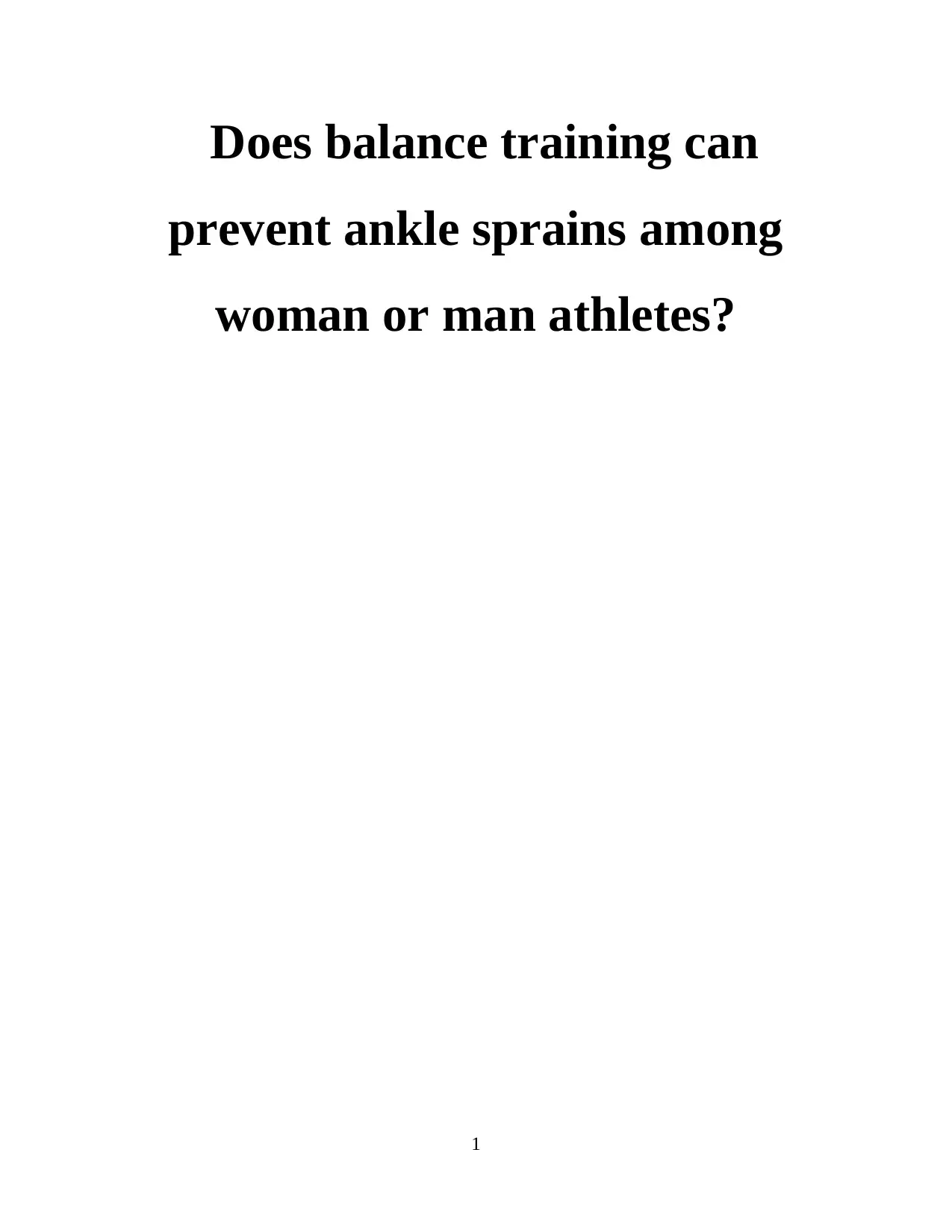
Does balance training can
prevent ankle sprains among
woman or man athletes?
1
prevent ankle sprains among
woman or man athletes?
1
Paraphrase This Document
Need a fresh take? Get an instant paraphrase of this document with our AI Paraphraser
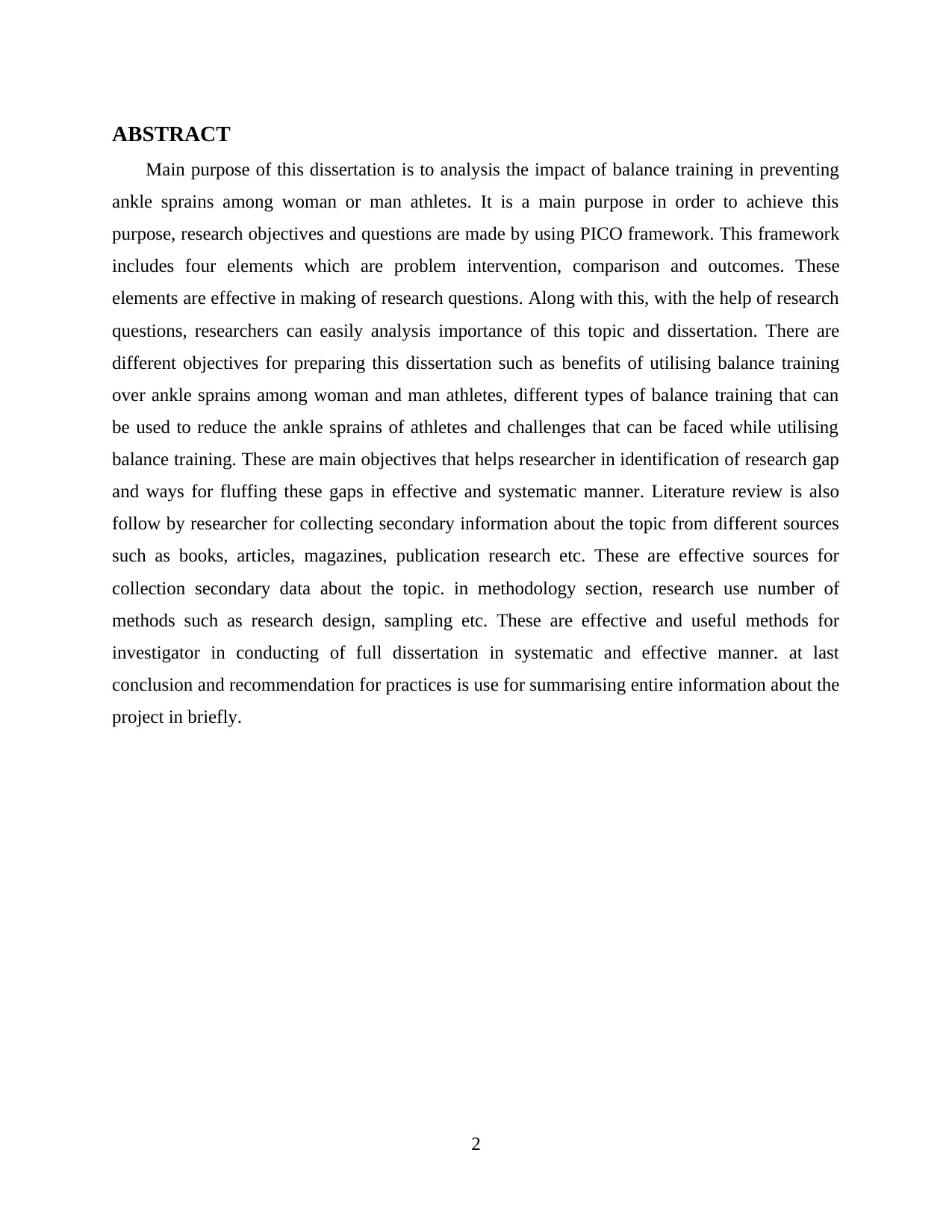
ABSTRACT
Main purpose of this dissertation is to analysis the impact of balance training in preventing
ankle sprains among woman or man athletes. It is a main purpose in order to achieve this
purpose, research objectives and questions are made by using PICO framework. This framework
includes four elements which are problem intervention, comparison and outcomes. These
elements are effective in making of research questions. Along with this, with the help of research
questions, researchers can easily analysis importance of this topic and dissertation. There are
different objectives for preparing this dissertation such as benefits of utilising balance training
over ankle sprains among woman and man athletes, different types of balance training that can
be used to reduce the ankle sprains of athletes and challenges that can be faced while utilising
balance training. These are main objectives that helps researcher in identification of research gap
and ways for fluffing these gaps in effective and systematic manner. Literature review is also
follow by researcher for collecting secondary information about the topic from different sources
such as books, articles, magazines, publication research etc. These are effective sources for
collection secondary data about the topic. in methodology section, research use number of
methods such as research design, sampling etc. These are effective and useful methods for
investigator in conducting of full dissertation in systematic and effective manner. at last
conclusion and recommendation for practices is use for summarising entire information about the
project in briefly.
2
Main purpose of this dissertation is to analysis the impact of balance training in preventing
ankle sprains among woman or man athletes. It is a main purpose in order to achieve this
purpose, research objectives and questions are made by using PICO framework. This framework
includes four elements which are problem intervention, comparison and outcomes. These
elements are effective in making of research questions. Along with this, with the help of research
questions, researchers can easily analysis importance of this topic and dissertation. There are
different objectives for preparing this dissertation such as benefits of utilising balance training
over ankle sprains among woman and man athletes, different types of balance training that can
be used to reduce the ankle sprains of athletes and challenges that can be faced while utilising
balance training. These are main objectives that helps researcher in identification of research gap
and ways for fluffing these gaps in effective and systematic manner. Literature review is also
follow by researcher for collecting secondary information about the topic from different sources
such as books, articles, magazines, publication research etc. These are effective sources for
collection secondary data about the topic. in methodology section, research use number of
methods such as research design, sampling etc. These are effective and useful methods for
investigator in conducting of full dissertation in systematic and effective manner. at last
conclusion and recommendation for practices is use for summarising entire information about the
project in briefly.
2
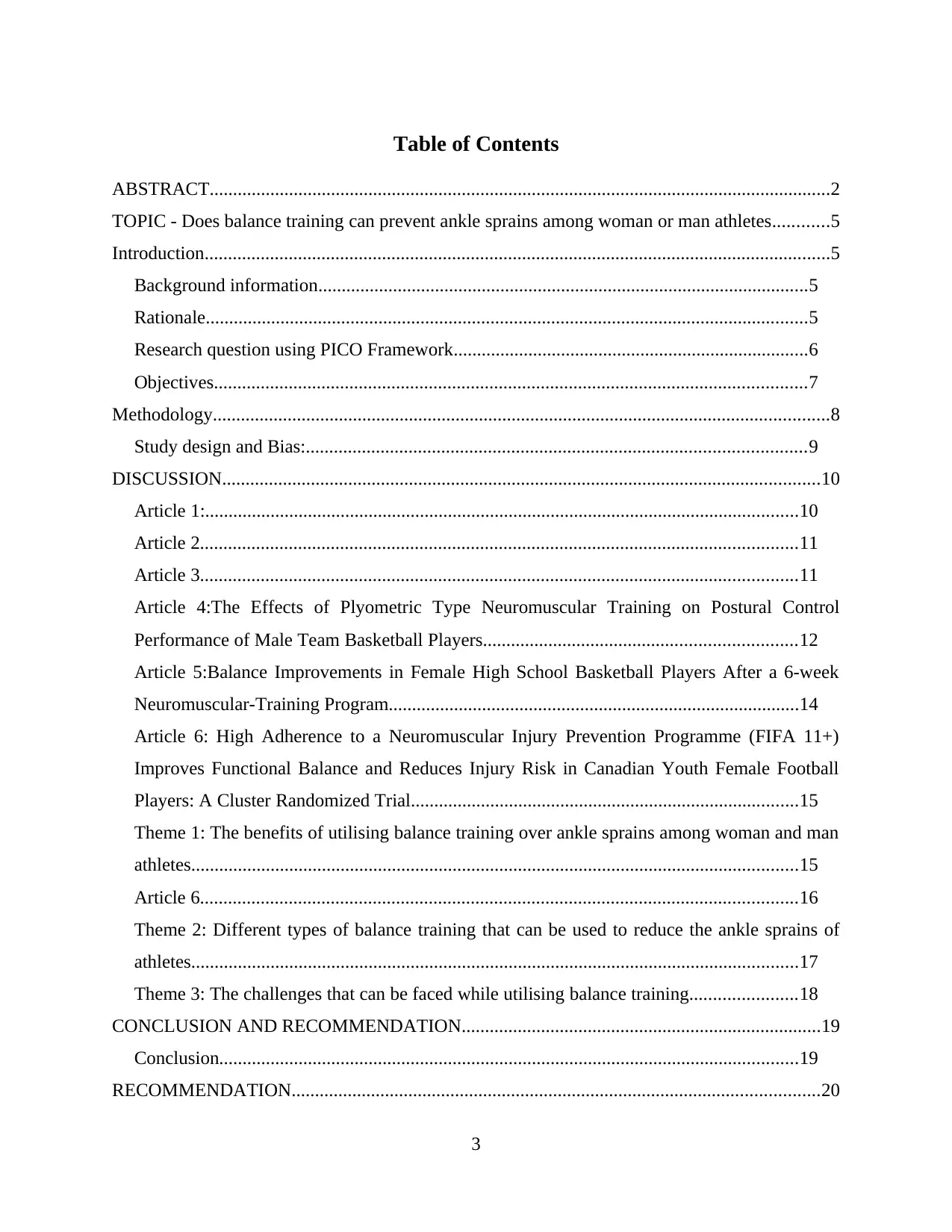
Table of Contents
ABSTRACT.....................................................................................................................................2
TOPIC - Does balance training can prevent ankle sprains among woman or man athletes............5
Introduction......................................................................................................................................5
Background information.........................................................................................................5
Rationale.................................................................................................................................5
Research question using PICO Framework............................................................................6
Objectives...............................................................................................................................7
Methodology....................................................................................................................................8
Study design and Bias:...........................................................................................................9
DISCUSSION................................................................................................................................10
Article 1:...............................................................................................................................10
Article 2................................................................................................................................11
Article 3................................................................................................................................11
Article 4:The Effects of Plyometric Type Neuromuscular Training on Postural Control
Performance of Male Team Basketball Players...................................................................12
Article 5:Balance Improvements in Female High School Basketball Players After a 6-week
Neuromuscular-Training Program........................................................................................14
Article 6: High Adherence to a Neuromuscular Injury Prevention Programme (FIFA 11+)
Improves Functional Balance and Reduces Injury Risk in Canadian Youth Female Football
Players: A Cluster Randomized Trial...................................................................................15
Theme 1: The benefits of utilising balance training over ankle sprains among woman and man
athletes..................................................................................................................................15
Article 6................................................................................................................................16
Theme 2: Different types of balance training that can be used to reduce the ankle sprains of
athletes..................................................................................................................................17
Theme 3: The challenges that can be faced while utilising balance training.......................18
CONCLUSION AND RECOMMENDATION.............................................................................19
Conclusion............................................................................................................................19
RECOMMENDATION.................................................................................................................20
3
ABSTRACT.....................................................................................................................................2
TOPIC - Does balance training can prevent ankle sprains among woman or man athletes............5
Introduction......................................................................................................................................5
Background information.........................................................................................................5
Rationale.................................................................................................................................5
Research question using PICO Framework............................................................................6
Objectives...............................................................................................................................7
Methodology....................................................................................................................................8
Study design and Bias:...........................................................................................................9
DISCUSSION................................................................................................................................10
Article 1:...............................................................................................................................10
Article 2................................................................................................................................11
Article 3................................................................................................................................11
Article 4:The Effects of Plyometric Type Neuromuscular Training on Postural Control
Performance of Male Team Basketball Players...................................................................12
Article 5:Balance Improvements in Female High School Basketball Players After a 6-week
Neuromuscular-Training Program........................................................................................14
Article 6: High Adherence to a Neuromuscular Injury Prevention Programme (FIFA 11+)
Improves Functional Balance and Reduces Injury Risk in Canadian Youth Female Football
Players: A Cluster Randomized Trial...................................................................................15
Theme 1: The benefits of utilising balance training over ankle sprains among woman and man
athletes..................................................................................................................................15
Article 6................................................................................................................................16
Theme 2: Different types of balance training that can be used to reduce the ankle sprains of
athletes..................................................................................................................................17
Theme 3: The challenges that can be faced while utilising balance training.......................18
CONCLUSION AND RECOMMENDATION.............................................................................19
Conclusion............................................................................................................................19
RECOMMENDATION.................................................................................................................20
3
⊘ This is a preview!⊘
Do you want full access?
Subscribe today to unlock all pages.

Trusted by 1+ million students worldwide

REFERENCES..............................................................................................................................22
Articles...........................................................................................................................................24
4
Articles...........................................................................................................................................24
4
Paraphrase This Document
Need a fresh take? Get an instant paraphrase of this document with our AI Paraphraser
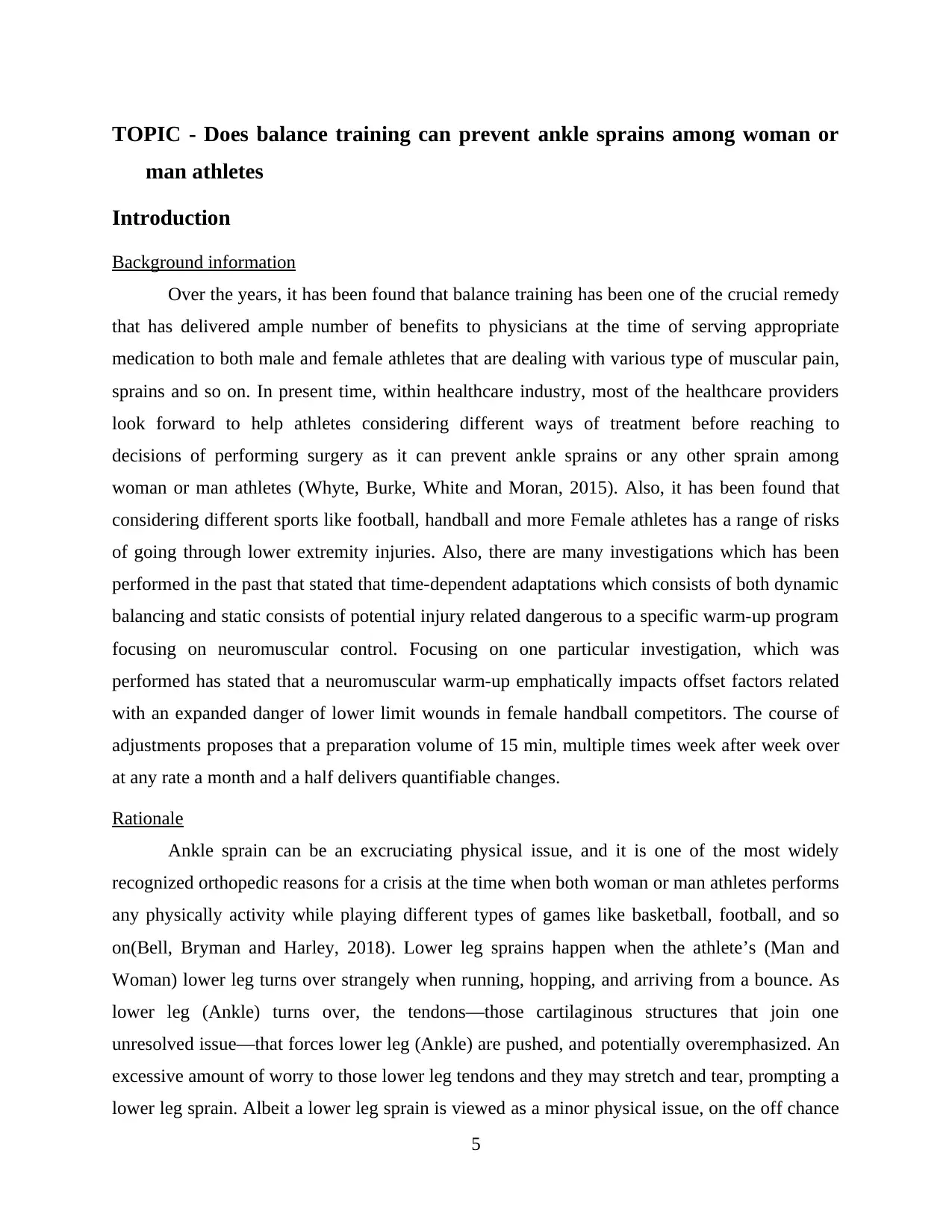
TOPIC - Does balance training can prevent ankle sprains among woman or
man athletes
Introduction
Background information
Over the years, it has been found that balance training has been one of the crucial remedy
that has delivered ample number of benefits to physicians at the time of serving appropriate
medication to both male and female athletes that are dealing with various type of muscular pain,
sprains and so on. In present time, within healthcare industry, most of the healthcare providers
look forward to help athletes considering different ways of treatment before reaching to
decisions of performing surgery as it can prevent ankle sprains or any other sprain among
woman or man athletes (Whyte, Burke, White and Moran, 2015). Also, it has been found that
considering different sports like football, handball and more Female athletes has a range of risks
of going through lower extremity injuries. Also, there are many investigations which has been
performed in the past that stated that time-dependent adaptations which consists of both dynamic
balancing and static consists of potential injury related dangerous to a specific warm-up program
focusing on neuromuscular control. Focusing on one particular investigation, which was
performed has stated that a neuromuscular warm-up emphatically impacts offset factors related
with an expanded danger of lower limit wounds in female handball competitors. The course of
adjustments proposes that a preparation volume of 15 min, multiple times week after week over
at any rate a month and a half delivers quantifiable changes.
Rationale
Ankle sprain can be an excruciating physical issue, and it is one of the most widely
recognized orthopedic reasons for a crisis at the time when both woman or man athletes performs
any physically activity while playing different types of games like basketball, football, and so
on(Bell, Bryman and Harley, 2018). Lower leg sprains happen when the athlete’s (Man and
Woman) lower leg turns over strangely when running, hopping, and arriving from a bounce. As
lower leg (Ankle) turns over, the tendons—those cartilaginous structures that join one
unresolved issue—that forces lower leg (Ankle) are pushed, and potentially overemphasized. An
excessive amount of worry to those lower leg tendons and they may stretch and tear, prompting a
lower leg sprain. Albeit a lower leg sprain is viewed as a minor physical issue, on the off chance
5
man athletes
Introduction
Background information
Over the years, it has been found that balance training has been one of the crucial remedy
that has delivered ample number of benefits to physicians at the time of serving appropriate
medication to both male and female athletes that are dealing with various type of muscular pain,
sprains and so on. In present time, within healthcare industry, most of the healthcare providers
look forward to help athletes considering different ways of treatment before reaching to
decisions of performing surgery as it can prevent ankle sprains or any other sprain among
woman or man athletes (Whyte, Burke, White and Moran, 2015). Also, it has been found that
considering different sports like football, handball and more Female athletes has a range of risks
of going through lower extremity injuries. Also, there are many investigations which has been
performed in the past that stated that time-dependent adaptations which consists of both dynamic
balancing and static consists of potential injury related dangerous to a specific warm-up program
focusing on neuromuscular control. Focusing on one particular investigation, which was
performed has stated that a neuromuscular warm-up emphatically impacts offset factors related
with an expanded danger of lower limit wounds in female handball competitors. The course of
adjustments proposes that a preparation volume of 15 min, multiple times week after week over
at any rate a month and a half delivers quantifiable changes.
Rationale
Ankle sprain can be an excruciating physical issue, and it is one of the most widely
recognized orthopedic reasons for a crisis at the time when both woman or man athletes performs
any physically activity while playing different types of games like basketball, football, and so
on(Bell, Bryman and Harley, 2018). Lower leg sprains happen when the athlete’s (Man and
Woman) lower leg turns over strangely when running, hopping, and arriving from a bounce. As
lower leg (Ankle) turns over, the tendons—those cartilaginous structures that join one
unresolved issue—that forces lower leg (Ankle) are pushed, and potentially overemphasized. An
excessive amount of worry to those lower leg tendons and they may stretch and tear, prompting a
lower leg sprain. Albeit a lower leg sprain is viewed as a minor physical issue, on the off chance
5
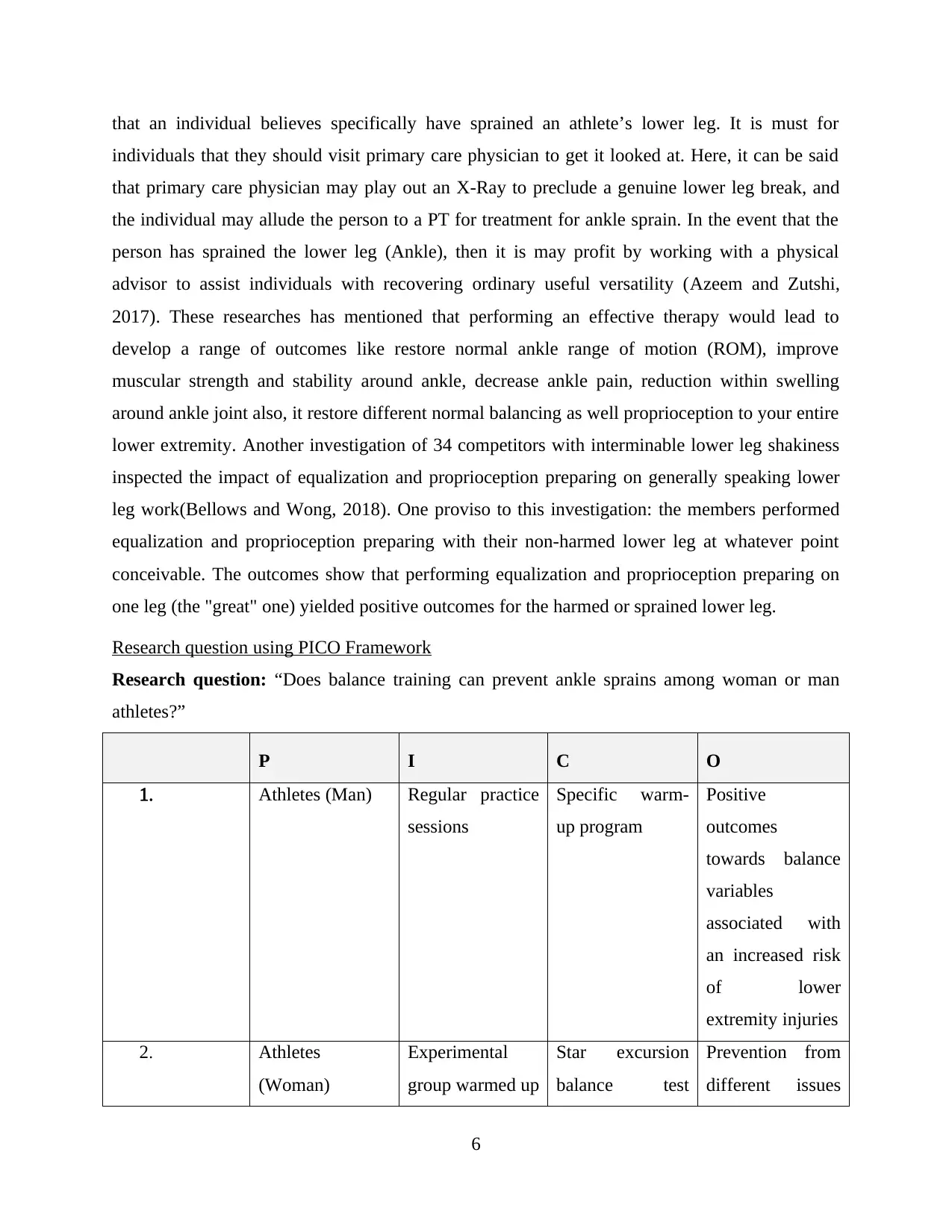
that an individual believes specifically have sprained an athlete’s lower leg. It is must for
individuals that they should visit primary care physician to get it looked at. Here, it can be said
that primary care physician may play out an X-Ray to preclude a genuine lower leg break, and
the individual may allude the person to a PT for treatment for ankle sprain. In the event that the
person has sprained the lower leg (Ankle), then it is may profit by working with a physical
advisor to assist individuals with recovering ordinary useful versatility (Azeem and Zutshi,
2017). These researches has mentioned that performing an effective therapy would lead to
develop a range of outcomes like restore normal ankle range of motion (ROM), improve
muscular strength and stability around ankle, decrease ankle pain, reduction within swelling
around ankle joint also, it restore different normal balancing as well proprioception to your entire
lower extremity. Another investigation of 34 competitors with interminable lower leg shakiness
inspected the impact of equalization and proprioception preparing on generally speaking lower
leg work(Bellows and Wong, 2018). One proviso to this investigation: the members performed
equalization and proprioception preparing with their non-harmed lower leg at whatever point
conceivable. The outcomes show that performing equalization and proprioception preparing on
one leg (the "great" one) yielded positive outcomes for the harmed or sprained lower leg.
Research question using PICO Framework
Research question: “Does balance training can prevent ankle sprains among woman or man
athletes?”
P I C O
1. Athletes (Man) Regular practice
sessions
Specific warm-
up program
Positive
outcomes
towards balance
variables
associated with
an increased risk
of lower
extremity injuries
2. Athletes
(Woman)
Experimental
group warmed up
Star excursion
balance test
Prevention from
different issues
6
individuals that they should visit primary care physician to get it looked at. Here, it can be said
that primary care physician may play out an X-Ray to preclude a genuine lower leg break, and
the individual may allude the person to a PT for treatment for ankle sprain. In the event that the
person has sprained the lower leg (Ankle), then it is may profit by working with a physical
advisor to assist individuals with recovering ordinary useful versatility (Azeem and Zutshi,
2017). These researches has mentioned that performing an effective therapy would lead to
develop a range of outcomes like restore normal ankle range of motion (ROM), improve
muscular strength and stability around ankle, decrease ankle pain, reduction within swelling
around ankle joint also, it restore different normal balancing as well proprioception to your entire
lower extremity. Another investigation of 34 competitors with interminable lower leg shakiness
inspected the impact of equalization and proprioception preparing on generally speaking lower
leg work(Bellows and Wong, 2018). One proviso to this investigation: the members performed
equalization and proprioception preparing with their non-harmed lower leg at whatever point
conceivable. The outcomes show that performing equalization and proprioception preparing on
one leg (the "great" one) yielded positive outcomes for the harmed or sprained lower leg.
Research question using PICO Framework
Research question: “Does balance training can prevent ankle sprains among woman or man
athletes?”
P I C O
1. Athletes (Man) Regular practice
sessions
Specific warm-
up program
Positive
outcomes
towards balance
variables
associated with
an increased risk
of lower
extremity injuries
2. Athletes
(Woman)
Experimental
group warmed up
Star excursion
balance test
Prevention from
different issues
6
⊘ This is a preview!⊘
Do you want full access?
Subscribe today to unlock all pages.

Trusted by 1+ million students worldwide
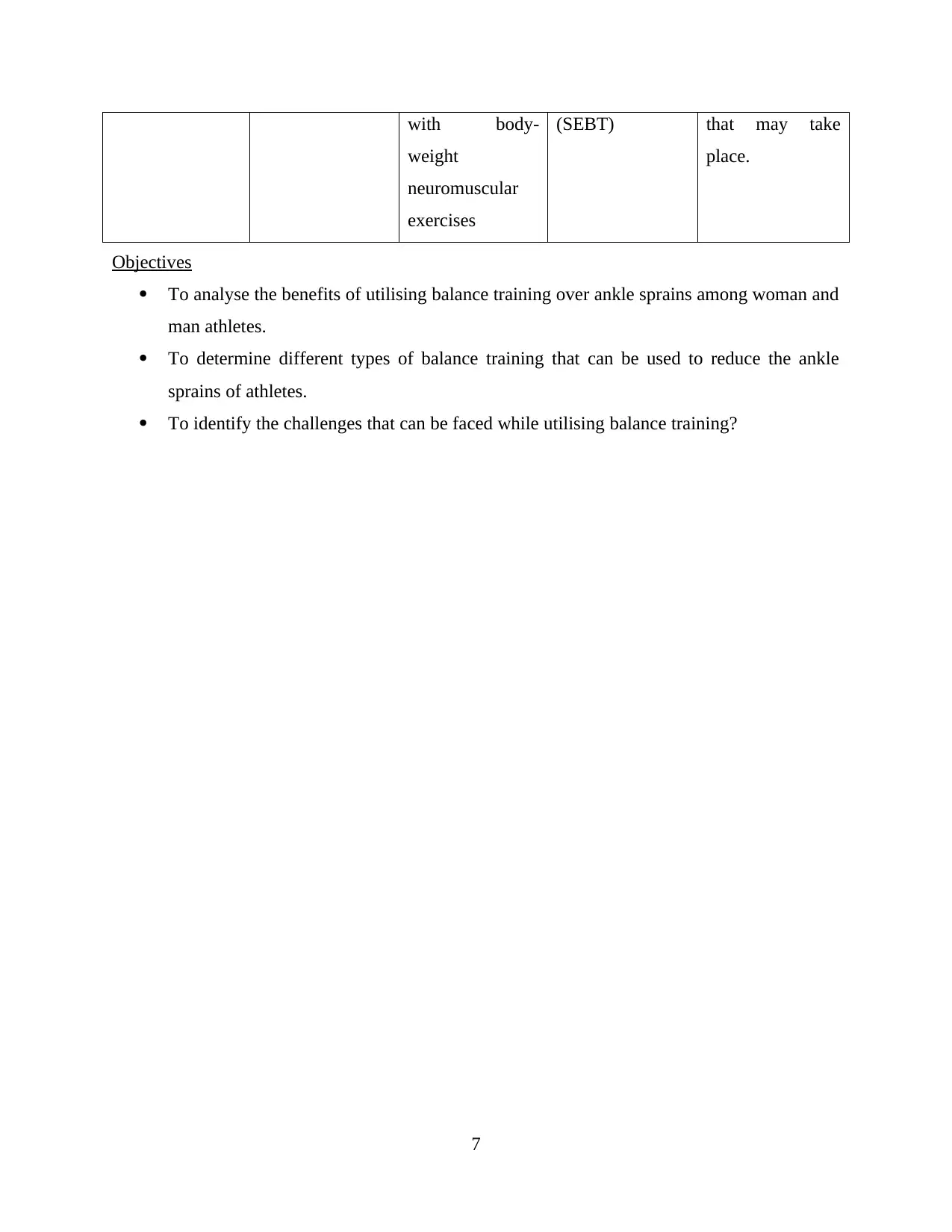
with body-
weight
neuromuscular
exercises
(SEBT) that may take
place.
Objectives
To analyse the benefits of utilising balance training over ankle sprains among woman and
man athletes.
To determine different types of balance training that can be used to reduce the ankle
sprains of athletes.
To identify the challenges that can be faced while utilising balance training?
7
weight
neuromuscular
exercises
(SEBT) that may take
place.
Objectives
To analyse the benefits of utilising balance training over ankle sprains among woman and
man athletes.
To determine different types of balance training that can be used to reduce the ankle
sprains of athletes.
To identify the challenges that can be faced while utilising balance training?
7
Paraphrase This Document
Need a fresh take? Get an instant paraphrase of this document with our AI Paraphraser
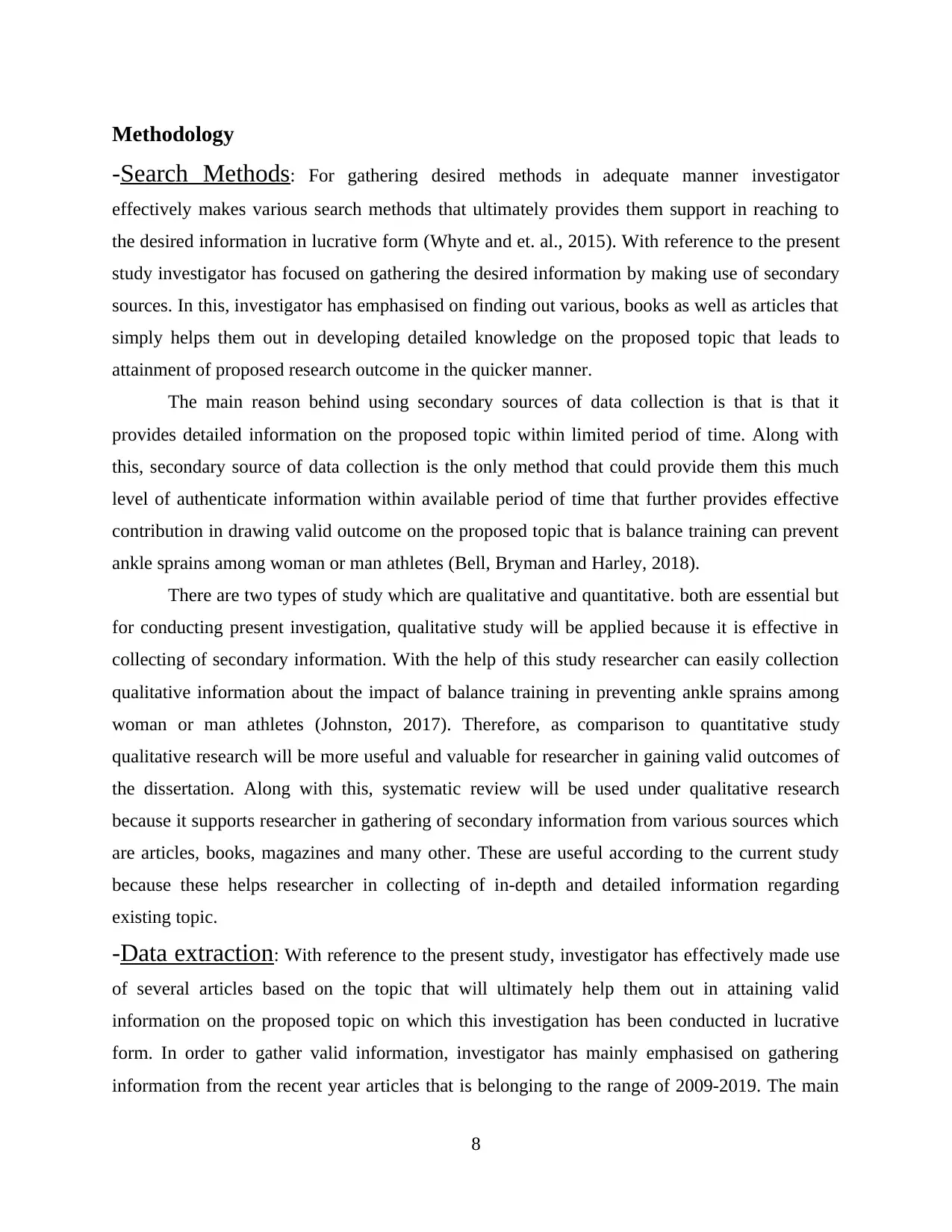
Methodology
-Search Methods: For gathering desired methods in adequate manner investigator
effectively makes various search methods that ultimately provides them support in reaching to
the desired information in lucrative form (Whyte and et. al., 2015). With reference to the present
study investigator has focused on gathering the desired information by making use of secondary
sources. In this, investigator has emphasised on finding out various, books as well as articles that
simply helps them out in developing detailed knowledge on the proposed topic that leads to
attainment of proposed research outcome in the quicker manner.
The main reason behind using secondary sources of data collection is that is that it
provides detailed information on the proposed topic within limited period of time. Along with
this, secondary source of data collection is the only method that could provide them this much
level of authenticate information within available period of time that further provides effective
contribution in drawing valid outcome on the proposed topic that is balance training can prevent
ankle sprains among woman or man athletes (Bell, Bryman and Harley, 2018).
There are two types of study which are qualitative and quantitative. both are essential but
for conducting present investigation, qualitative study will be applied because it is effective in
collecting of secondary information. With the help of this study researcher can easily collection
qualitative information about the impact of balance training in preventing ankle sprains among
woman or man athletes (Johnston, 2017). Therefore, as comparison to quantitative study
qualitative research will be more useful and valuable for researcher in gaining valid outcomes of
the dissertation. Along with this, systematic review will be used under qualitative research
because it supports researcher in gathering of secondary information from various sources which
are articles, books, magazines and many other. These are useful according to the current study
because these helps researcher in collecting of in-depth and detailed information regarding
existing topic.
-Data extraction: With reference to the present study, investigator has effectively made use
of several articles based on the topic that will ultimately help them out in attaining valid
information on the proposed topic on which this investigation has been conducted in lucrative
form. In order to gather valid information, investigator has mainly emphasised on gathering
information from the recent year articles that is belonging to the range of 2009-2019. The main
8
-Search Methods: For gathering desired methods in adequate manner investigator
effectively makes various search methods that ultimately provides them support in reaching to
the desired information in lucrative form (Whyte and et. al., 2015). With reference to the present
study investigator has focused on gathering the desired information by making use of secondary
sources. In this, investigator has emphasised on finding out various, books as well as articles that
simply helps them out in developing detailed knowledge on the proposed topic that leads to
attainment of proposed research outcome in the quicker manner.
The main reason behind using secondary sources of data collection is that is that it
provides detailed information on the proposed topic within limited period of time. Along with
this, secondary source of data collection is the only method that could provide them this much
level of authenticate information within available period of time that further provides effective
contribution in drawing valid outcome on the proposed topic that is balance training can prevent
ankle sprains among woman or man athletes (Bell, Bryman and Harley, 2018).
There are two types of study which are qualitative and quantitative. both are essential but
for conducting present investigation, qualitative study will be applied because it is effective in
collecting of secondary information. With the help of this study researcher can easily collection
qualitative information about the impact of balance training in preventing ankle sprains among
woman or man athletes (Johnston, 2017). Therefore, as comparison to quantitative study
qualitative research will be more useful and valuable for researcher in gaining valid outcomes of
the dissertation. Along with this, systematic review will be used under qualitative research
because it supports researcher in gathering of secondary information from various sources which
are articles, books, magazines and many other. These are useful according to the current study
because these helps researcher in collecting of in-depth and detailed information regarding
existing topic.
-Data extraction: With reference to the present study, investigator has effectively made use
of several articles based on the topic that will ultimately help them out in attaining valid
information on the proposed topic on which this investigation has been conducted in lucrative
form. In order to gather valid information, investigator has mainly emphasised on gathering
information from the recent year articles that is belonging to the range of 2009-2019. The main
8
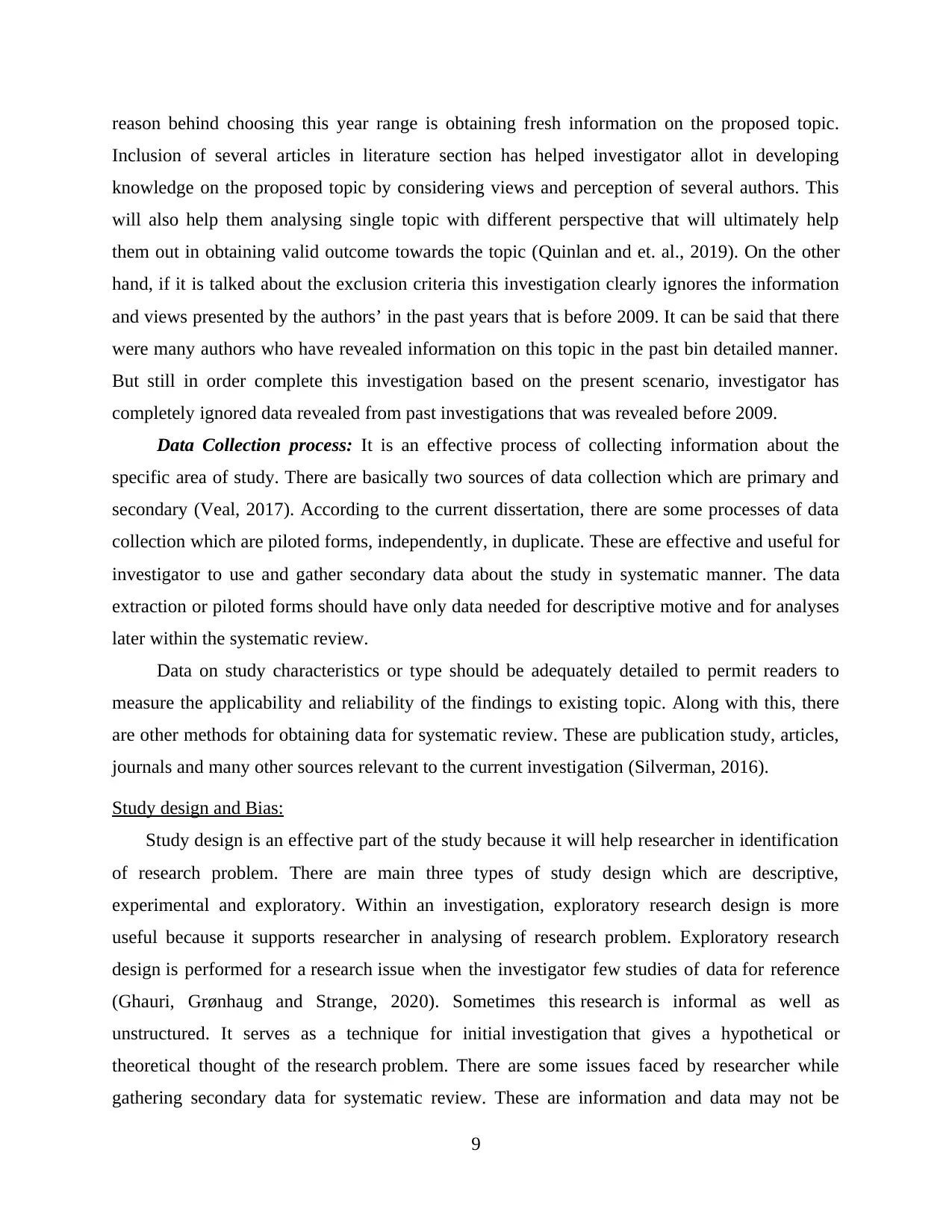
reason behind choosing this year range is obtaining fresh information on the proposed topic.
Inclusion of several articles in literature section has helped investigator allot in developing
knowledge on the proposed topic by considering views and perception of several authors. This
will also help them analysing single topic with different perspective that will ultimately help
them out in obtaining valid outcome towards the topic (Quinlan and et. al., 2019). On the other
hand, if it is talked about the exclusion criteria this investigation clearly ignores the information
and views presented by the authors’ in the past years that is before 2009. It can be said that there
were many authors who have revealed information on this topic in the past bin detailed manner.
But still in order complete this investigation based on the present scenario, investigator has
completely ignored data revealed from past investigations that was revealed before 2009.
Data Collection process: It is an effective process of collecting information about the
specific area of study. There are basically two sources of data collection which are primary and
secondary (Veal, 2017). According to the current dissertation, there are some processes of data
collection which are piloted forms, independently, in duplicate. These are effective and useful for
investigator to use and gather secondary data about the study in systematic manner. The data
extraction or piloted forms should have only data needed for descriptive motive and for analyses
later within the systematic review.
Data on study characteristics or type should be adequately detailed to permit readers to
measure the applicability and reliability of the findings to existing topic. Along with this, there
are other methods for obtaining data for systematic review. These are publication study, articles,
journals and many other sources relevant to the current investigation (Silverman, 2016).
Study design and Bias:
Study design is an effective part of the study because it will help researcher in identification
of research problem. There are main three types of study design which are descriptive,
experimental and exploratory. Within an investigation, exploratory research design is more
useful because it supports researcher in analysing of research problem. Exploratory research
design is performed for a research issue when the investigator few studies of data for reference
(Ghauri, Grønhaug and Strange, 2020). Sometimes this research is informal as well as
unstructured. It serves as a technique for initial investigation that gives a hypothetical or
theoretical thought of the research problem. There are some issues faced by researcher while
gathering secondary data for systematic review. These are information and data may not be
9
Inclusion of several articles in literature section has helped investigator allot in developing
knowledge on the proposed topic by considering views and perception of several authors. This
will also help them analysing single topic with different perspective that will ultimately help
them out in obtaining valid outcome towards the topic (Quinlan and et. al., 2019). On the other
hand, if it is talked about the exclusion criteria this investigation clearly ignores the information
and views presented by the authors’ in the past years that is before 2009. It can be said that there
were many authors who have revealed information on this topic in the past bin detailed manner.
But still in order complete this investigation based on the present scenario, investigator has
completely ignored data revealed from past investigations that was revealed before 2009.
Data Collection process: It is an effective process of collecting information about the
specific area of study. There are basically two sources of data collection which are primary and
secondary (Veal, 2017). According to the current dissertation, there are some processes of data
collection which are piloted forms, independently, in duplicate. These are effective and useful for
investigator to use and gather secondary data about the study in systematic manner. The data
extraction or piloted forms should have only data needed for descriptive motive and for analyses
later within the systematic review.
Data on study characteristics or type should be adequately detailed to permit readers to
measure the applicability and reliability of the findings to existing topic. Along with this, there
are other methods for obtaining data for systematic review. These are publication study, articles,
journals and many other sources relevant to the current investigation (Silverman, 2016).
Study design and Bias:
Study design is an effective part of the study because it will help researcher in identification
of research problem. There are main three types of study design which are descriptive,
experimental and exploratory. Within an investigation, exploratory research design is more
useful because it supports researcher in analysing of research problem. Exploratory research
design is performed for a research issue when the investigator few studies of data for reference
(Ghauri, Grønhaug and Strange, 2020). Sometimes this research is informal as well as
unstructured. It serves as a technique for initial investigation that gives a hypothetical or
theoretical thought of the research problem. There are some issues faced by researcher while
gathering secondary data for systematic review. These are information and data may not be
9
⊘ This is a preview!⊘
Do you want full access?
Subscribe today to unlock all pages.

Trusted by 1+ million students worldwide
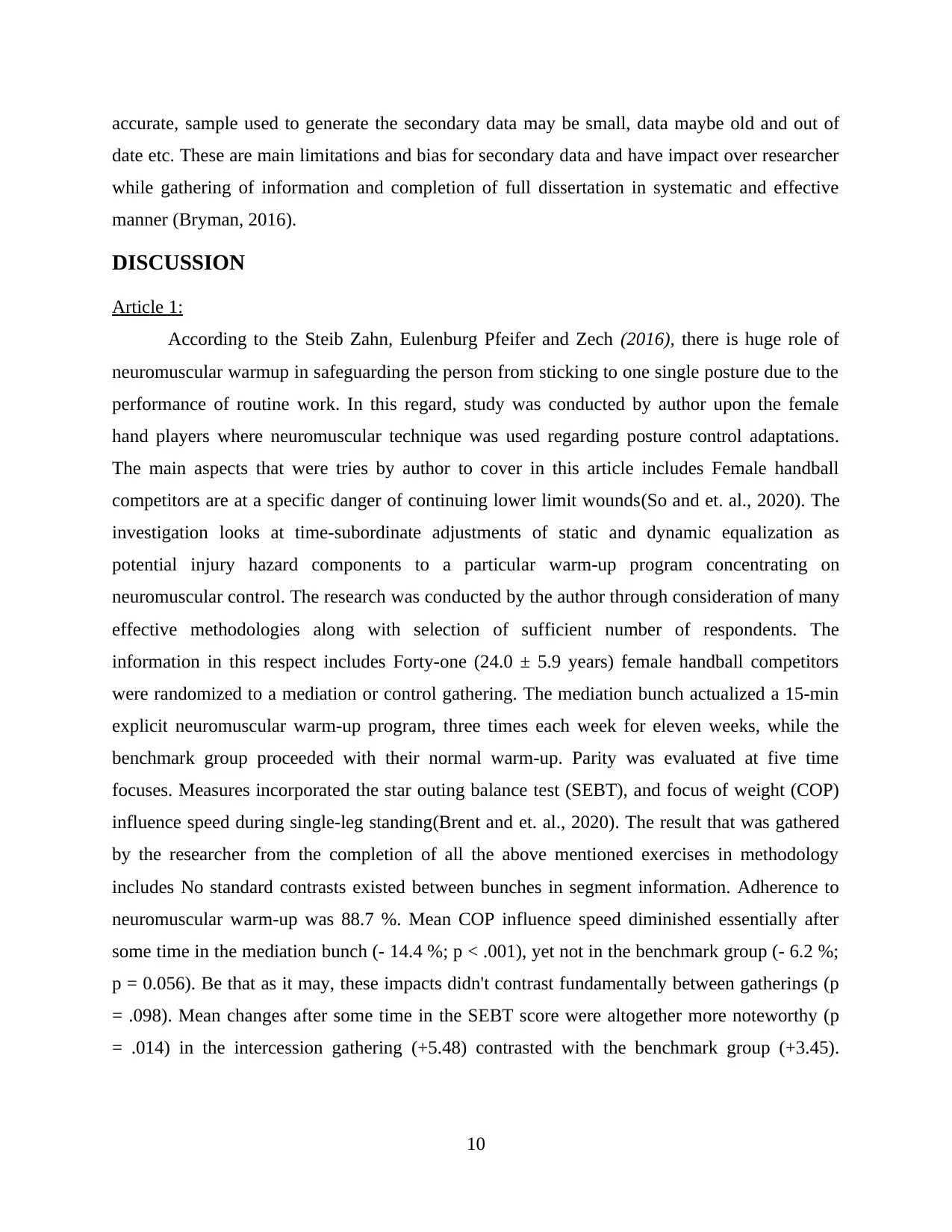
accurate, sample used to generate the secondary data may be small, data maybe old and out of
date etc. These are main limitations and bias for secondary data and have impact over researcher
while gathering of information and completion of full dissertation in systematic and effective
manner (Bryman, 2016).
DISCUSSION
Article 1:
According to the Steib Zahn, Eulenburg Pfeifer and Zech (2016), there is huge role of
neuromuscular warmup in safeguarding the person from sticking to one single posture due to the
performance of routine work. In this regard, study was conducted by author upon the female
hand players where neuromuscular technique was used regarding posture control adaptations.
The main aspects that were tries by author to cover in this article includes Female handball
competitors are at a specific danger of continuing lower limit wounds(So and et. al., 2020). The
investigation looks at time-subordinate adjustments of static and dynamic equalization as
potential injury hazard components to a particular warm-up program concentrating on
neuromuscular control. The research was conducted by the author through consideration of many
effective methodologies along with selection of sufficient number of respondents. The
information in this respect includes Forty-one (24.0 ± 5.9 years) female handball competitors
were randomized to a mediation or control gathering. The mediation bunch actualized a 15-min
explicit neuromuscular warm-up program, three times each week for eleven weeks, while the
benchmark group proceeded with their normal warm-up. Parity was evaluated at five time
focuses. Measures incorporated the star outing balance test (SEBT), and focus of weight (COP)
influence speed during single-leg standing(Brent and et. al., 2020). The result that was gathered
by the researcher from the completion of all the above mentioned exercises in methodology
includes No standard contrasts existed between bunches in segment information. Adherence to
neuromuscular warm-up was 88.7 %. Mean COP influence speed diminished essentially after
some time in the mediation bunch (- 14.4 %; p < .001), yet not in the benchmark group (- 6.2 %;
p = 0.056). Be that as it may, these impacts didn't contrast fundamentally between gatherings (p
= .098). Mean changes after some time in the SEBT score were altogether more noteworthy (p
= .014) in the intercession gathering (+5.48) contrasted with the benchmark group (+3.45).
10
date etc. These are main limitations and bias for secondary data and have impact over researcher
while gathering of information and completion of full dissertation in systematic and effective
manner (Bryman, 2016).
DISCUSSION
Article 1:
According to the Steib Zahn, Eulenburg Pfeifer and Zech (2016), there is huge role of
neuromuscular warmup in safeguarding the person from sticking to one single posture due to the
performance of routine work. In this regard, study was conducted by author upon the female
hand players where neuromuscular technique was used regarding posture control adaptations.
The main aspects that were tries by author to cover in this article includes Female handball
competitors are at a specific danger of continuing lower limit wounds(So and et. al., 2020). The
investigation looks at time-subordinate adjustments of static and dynamic equalization as
potential injury hazard components to a particular warm-up program concentrating on
neuromuscular control. The research was conducted by the author through consideration of many
effective methodologies along with selection of sufficient number of respondents. The
information in this respect includes Forty-one (24.0 ± 5.9 years) female handball competitors
were randomized to a mediation or control gathering. The mediation bunch actualized a 15-min
explicit neuromuscular warm-up program, three times each week for eleven weeks, while the
benchmark group proceeded with their normal warm-up. Parity was evaluated at five time
focuses. Measures incorporated the star outing balance test (SEBT), and focus of weight (COP)
influence speed during single-leg standing(Brent and et. al., 2020). The result that was gathered
by the researcher from the completion of all the above mentioned exercises in methodology
includes No standard contrasts existed between bunches in segment information. Adherence to
neuromuscular warm-up was 88.7 %. Mean COP influence speed diminished essentially after
some time in the mediation bunch (- 14.4 %; p < .001), yet not in the benchmark group (- 6.2 %;
p = 0.056). Be that as it may, these impacts didn't contrast fundamentally between gatherings (p
= .098). Mean changes after some time in the SEBT score were altogether more noteworthy (p
= .014) in the intercession gathering (+5.48) contrasted with the benchmark group (+3.45).
10
Paraphrase This Document
Need a fresh take? Get an instant paraphrase of this document with our AI Paraphraser
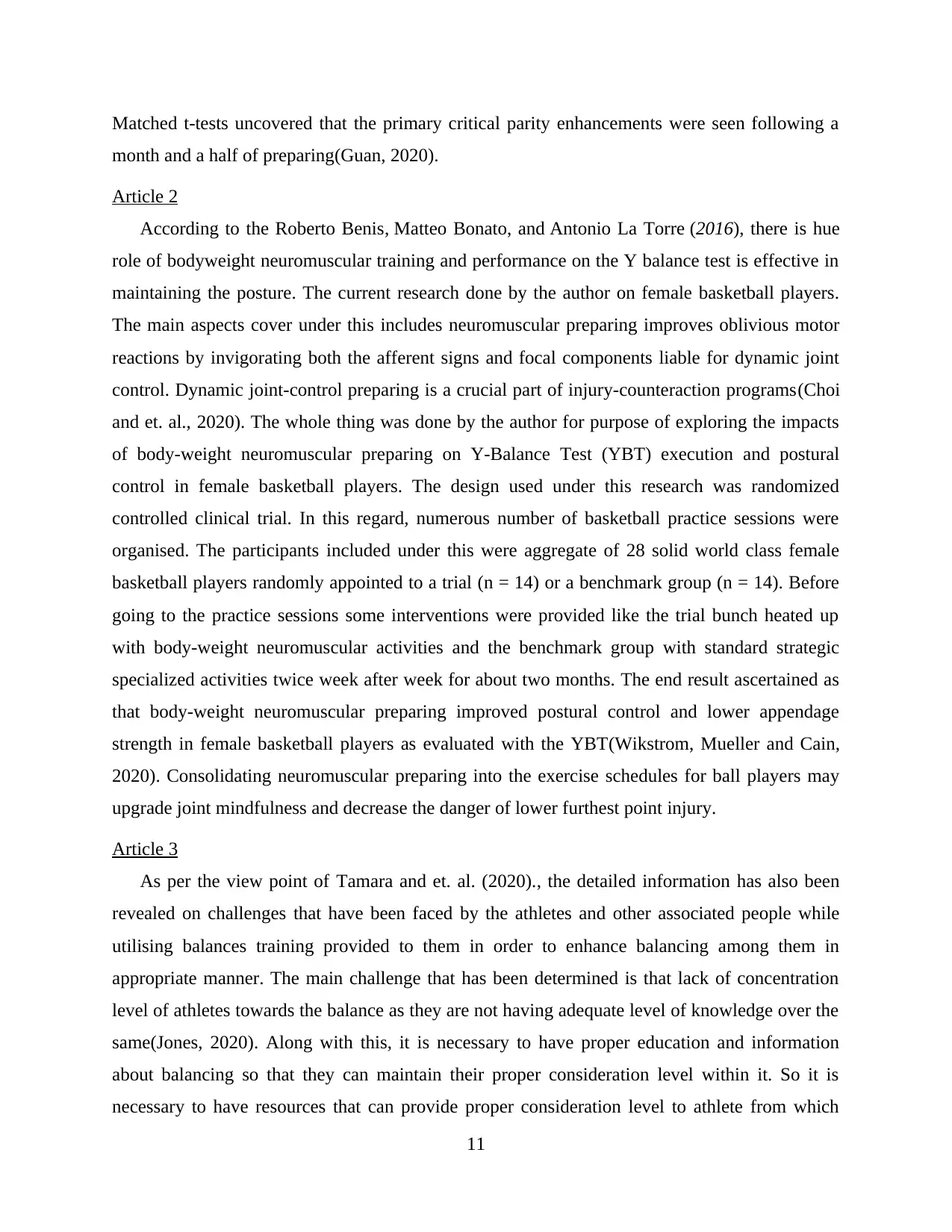
Matched t-tests uncovered that the primary critical parity enhancements were seen following a
month and a half of preparing(Guan, 2020).
Article 2
According to the Roberto Benis, Matteo Bonato, and Antonio La Torre (2016), there is hue
role of bodyweight neuromuscular training and performance on the Y balance test is effective in
maintaining the posture. The current research done by the author on female basketball players.
The main aspects cover under this includes neuromuscular preparing improves oblivious motor
reactions by invigorating both the afferent signs and focal components liable for dynamic joint
control. Dynamic joint-control preparing is a crucial part of injury-counteraction programs(Choi
and et. al., 2020). The whole thing was done by the author for purpose of exploring the impacts
of body-weight neuromuscular preparing on Y-Balance Test (YBT) execution and postural
control in female basketball players. The design used under this research was randomized
controlled clinical trial. In this regard, numerous number of basketball practice sessions were
organised. The participants included under this were aggregate of 28 solid world class female
basketball players randomly appointed to a trial (n = 14) or a benchmark group (n = 14). Before
going to the practice sessions some interventions were provided like the trial bunch heated up
with body-weight neuromuscular activities and the benchmark group with standard strategic
specialized activities twice week after week for about two months. The end result ascertained as
that body-weight neuromuscular preparing improved postural control and lower appendage
strength in female basketball players as evaluated with the YBT(Wikstrom, Mueller and Cain,
2020). Consolidating neuromuscular preparing into the exercise schedules for ball players may
upgrade joint mindfulness and decrease the danger of lower furthest point injury.
Article 3
As per the view point of Tamara and et. al. (2020)., the detailed information has also been
revealed on challenges that have been faced by the athletes and other associated people while
utilising balances training provided to them in order to enhance balancing among them in
appropriate manner. The main challenge that has been determined is that lack of concentration
level of athletes towards the balance as they are not having adequate level of knowledge over the
same(Jones, 2020). Along with this, it is necessary to have proper education and information
about balancing so that they can maintain their proper consideration level within it. So it is
necessary to have resources that can provide proper consideration level to athlete from which
11
month and a half of preparing(Guan, 2020).
Article 2
According to the Roberto Benis, Matteo Bonato, and Antonio La Torre (2016), there is hue
role of bodyweight neuromuscular training and performance on the Y balance test is effective in
maintaining the posture. The current research done by the author on female basketball players.
The main aspects cover under this includes neuromuscular preparing improves oblivious motor
reactions by invigorating both the afferent signs and focal components liable for dynamic joint
control. Dynamic joint-control preparing is a crucial part of injury-counteraction programs(Choi
and et. al., 2020). The whole thing was done by the author for purpose of exploring the impacts
of body-weight neuromuscular preparing on Y-Balance Test (YBT) execution and postural
control in female basketball players. The design used under this research was randomized
controlled clinical trial. In this regard, numerous number of basketball practice sessions were
organised. The participants included under this were aggregate of 28 solid world class female
basketball players randomly appointed to a trial (n = 14) or a benchmark group (n = 14). Before
going to the practice sessions some interventions were provided like the trial bunch heated up
with body-weight neuromuscular activities and the benchmark group with standard strategic
specialized activities twice week after week for about two months. The end result ascertained as
that body-weight neuromuscular preparing improved postural control and lower appendage
strength in female basketball players as evaluated with the YBT(Wikstrom, Mueller and Cain,
2020). Consolidating neuromuscular preparing into the exercise schedules for ball players may
upgrade joint mindfulness and decrease the danger of lower furthest point injury.
Article 3
As per the view point of Tamara and et. al. (2020)., the detailed information has also been
revealed on challenges that have been faced by the athletes and other associated people while
utilising balances training provided to them in order to enhance balancing among them in
appropriate manner. The main challenge that has been determined is that lack of concentration
level of athletes towards the balance as they are not having adequate level of knowledge over the
same(Jones, 2020). Along with this, it is necessary to have proper education and information
about balancing so that they can maintain their proper consideration level within it. So it is
necessary to have resources that can provide proper consideration level to athlete from which
11
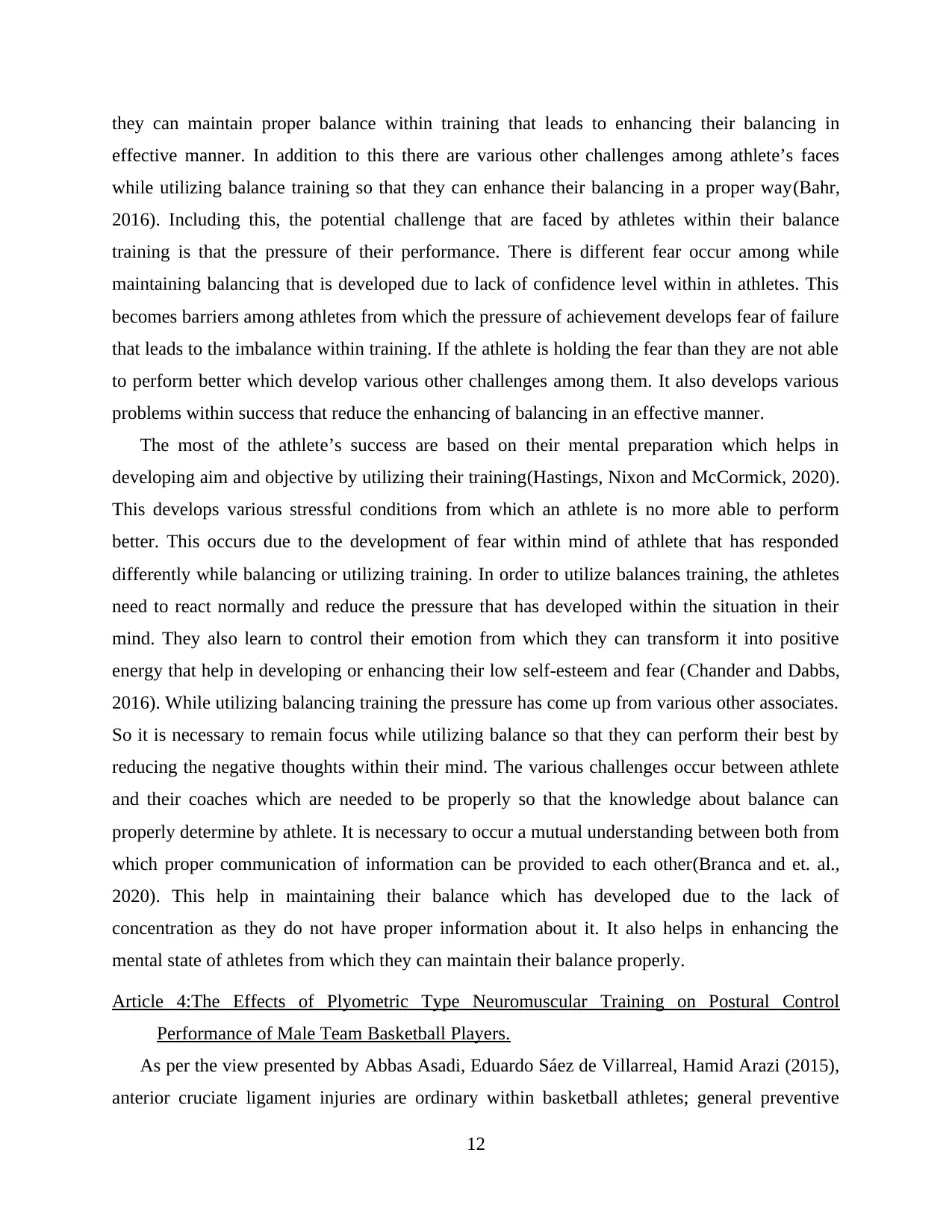
they can maintain proper balance within training that leads to enhancing their balancing in
effective manner. In addition to this there are various other challenges among athlete’s faces
while utilizing balance training so that they can enhance their balancing in a proper way(Bahr,
2016). Including this, the potential challenge that are faced by athletes within their balance
training is that the pressure of their performance. There is different fear occur among while
maintaining balancing that is developed due to lack of confidence level within in athletes. This
becomes barriers among athletes from which the pressure of achievement develops fear of failure
that leads to the imbalance within training. If the athlete is holding the fear than they are not able
to perform better which develop various other challenges among them. It also develops various
problems within success that reduce the enhancing of balancing in an effective manner.
The most of the athlete’s success are based on their mental preparation which helps in
developing aim and objective by utilizing their training(Hastings, Nixon and McCormick, 2020).
This develops various stressful conditions from which an athlete is no more able to perform
better. This occurs due to the development of fear within mind of athlete that has responded
differently while balancing or utilizing training. In order to utilize balances training, the athletes
need to react normally and reduce the pressure that has developed within the situation in their
mind. They also learn to control their emotion from which they can transform it into positive
energy that help in developing or enhancing their low self-esteem and fear (Chander and Dabbs,
2016). While utilizing balancing training the pressure has come up from various other associates.
So it is necessary to remain focus while utilizing balance so that they can perform their best by
reducing the negative thoughts within their mind. The various challenges occur between athlete
and their coaches which are needed to be properly so that the knowledge about balance can
properly determine by athlete. It is necessary to occur a mutual understanding between both from
which proper communication of information can be provided to each other(Branca and et. al.,
2020). This help in maintaining their balance which has developed due to the lack of
concentration as they do not have proper information about it. It also helps in enhancing the
mental state of athletes from which they can maintain their balance properly.
Article 4:The Effects of Plyometric Type Neuromuscular Training on Postural Control
Performance of Male Team Basketball Players.
As per the view presented by Abbas Asadi, Eduardo Sáez de Villarreal, Hamid Arazi (2015),
anterior cruciate ligament injuries are ordinary within basketball athletes; general preventive
12
effective manner. In addition to this there are various other challenges among athlete’s faces
while utilizing balance training so that they can enhance their balancing in a proper way(Bahr,
2016). Including this, the potential challenge that are faced by athletes within their balance
training is that the pressure of their performance. There is different fear occur among while
maintaining balancing that is developed due to lack of confidence level within in athletes. This
becomes barriers among athletes from which the pressure of achievement develops fear of failure
that leads to the imbalance within training. If the athlete is holding the fear than they are not able
to perform better which develop various other challenges among them. It also develops various
problems within success that reduce the enhancing of balancing in an effective manner.
The most of the athlete’s success are based on their mental preparation which helps in
developing aim and objective by utilizing their training(Hastings, Nixon and McCormick, 2020).
This develops various stressful conditions from which an athlete is no more able to perform
better. This occurs due to the development of fear within mind of athlete that has responded
differently while balancing or utilizing training. In order to utilize balances training, the athletes
need to react normally and reduce the pressure that has developed within the situation in their
mind. They also learn to control their emotion from which they can transform it into positive
energy that help in developing or enhancing their low self-esteem and fear (Chander and Dabbs,
2016). While utilizing balancing training the pressure has come up from various other associates.
So it is necessary to remain focus while utilizing balance so that they can perform their best by
reducing the negative thoughts within their mind. The various challenges occur between athlete
and their coaches which are needed to be properly so that the knowledge about balance can
properly determine by athlete. It is necessary to occur a mutual understanding between both from
which proper communication of information can be provided to each other(Branca and et. al.,
2020). This help in maintaining their balance which has developed due to the lack of
concentration as they do not have proper information about it. It also helps in enhancing the
mental state of athletes from which they can maintain their balance properly.
Article 4:The Effects of Plyometric Type Neuromuscular Training on Postural Control
Performance of Male Team Basketball Players.
As per the view presented by Abbas Asadi, Eduardo Sáez de Villarreal, Hamid Arazi (2015),
anterior cruciate ligament injuries are ordinary within basketball athletes; general preventive
12
⊘ This is a preview!⊘
Do you want full access?
Subscribe today to unlock all pages.

Trusted by 1+ million students worldwide
1 out of 27
Related Documents
Your All-in-One AI-Powered Toolkit for Academic Success.
+13062052269
info@desklib.com
Available 24*7 on WhatsApp / Email
![[object Object]](/_next/static/media/star-bottom.7253800d.svg)
Unlock your academic potential
Copyright © 2020–2025 A2Z Services. All Rights Reserved. Developed and managed by ZUCOL.




